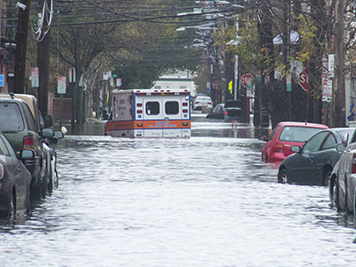FBW | January 30, 2013
The National Flood Insurance Program collects annually about $3.5 billion in premiums. Four times in the past eight years, however, claims paid out have exceeded premiums collected. In 2005, after Hurricane Katrina, claims totaled $17.7 billion. The claims paid for superstorm Sandy are expected to reach $7 billion. In order to stop subsidizing flood insurance claims, the federal government is expected to increase rates substantially for building owners in flood zones.
But for Hoboken property owners, there could be some relief if the City of Hoboken takes action. Flood insurance premiums can be reduced by as much as 45% if the City chooses to participate in the Federal Emergency Management Agency’s (FEMA) Community Rating System (CRS) and scores the highest marks possible.
The National Flood Insurance Program’s CRS is a voluntary incentive program that recognizes and encourages community floodplain management activities that exceed the federal government’s minimum requirements. The primary goals of CRS are to reduce flood damage to insurable property and encourage a comprehensive approach to floodplain management.
Communities participating in CRS can earn points by undertaking a number of measures. Open space preservation and acquisition & relocation programs in flood zones earn points. A series of outreach and education programs to inform building owners in flood area are a fundamental part of the rating system. Elevation certificates for the construction of new buildings are another element. Changes to zoning and building codes also lead to higher ratings for municipalities.
FEMA’s flood maps, newly released at the end of last year and revised for the first time in 25 years, form the basis for municipal participation in CRS. For Hoboken, 79% of the city falls within the flood zone. Although most of the town falls within the Advisory Base Flood Elevation (ABFE) A Zone, the entire coastline along the Hudson River is in the ABFE V Zone which is the Coastal High Hazard Zone that requires stricter standards and higher elevations for building. The proposed Monarch Towers, Union Dry Dock, the Stevens Institute waterfront parcel and much of the Hoboken Rail Yards are in the Coastal High Hazard Zone.
The premium reduction is similar to the classifications used for fire insurance. A Class 1 provides a 45% premium reduction. A Class 10 provides no reduction. The CRS Class is based on the number of floodplain management activities a community implements. In many cases, these are activities already implemented by the community, the state or a regional agency. The more activities implemented, the better the CRS class.

Flooding in Hoboken during super-storm Sandy. Photo credit: Jean-Paul Picard.
Prior to the 1950s, private insurance companies covered flood insurance in their standard home owners’ insurance policies. But after sustaining heavy losses, private insurance companies began dropping flood coverage and by the mid-1960s, private carriers completely dropped insurance for flooding. As a result, in 1968, the U.S. Congress created the National Flood Insurance Program, thus enabling property owners in participating communities to purchase flood insurance protection from the federal government. Today, the program insures about 5.5 million homes, most of which are in Texas, Louisiana and Florida.
Although originally designed to be self-supporting, a 2003 study revealed repetitive-loss properties costing the National Flood Insurance Program about $200 million annually. Since 1978, this federal program has paid more than $38 billion in claims, 40% of which has gone to Louisiana property owners. Beginning in 1973, the purchase of flood insurance became required by banks providing mortgages for properties in flood zones as defined by FEMA.
Related links
RBD floodwalls would have had no impact on Friday’s flash flooding
NYC’s flood hazard maps found to be inaccurate
Sea level rise will put half of Hoboken underwater by next century
Are Hoboken’s proposed floodwalls based on overstated risk?
What are best strategies for making Hoboken flood resilient?
FBW Comments to NJDEP 8-17-2016
Flood Hazard Assessment for New York Harbor
City of Hoboken’s Resilient Buildings Design Guidelines
Walling off Hoboken’s waterfront meets fierce resistance
Scoping out Hudson River Rebuild by Design project
Questions about Hoboken’s flood strategy
Dutch-led team: Resist, Delay, Store & Discharge – A Comprehensive Strategy for Hoboken
Are we devising flood remedies based on a 1,000 year storm?
Dutch Dialogues: A model for Hoboken
Flood insurance rates will skyrocket
79% of Hoboken falls into FEMA’s flood zone

